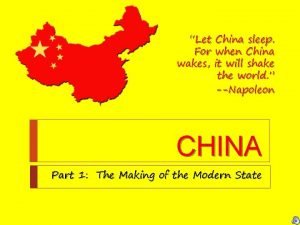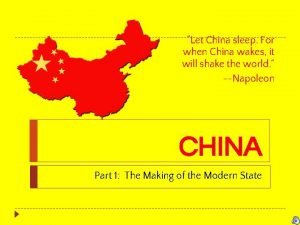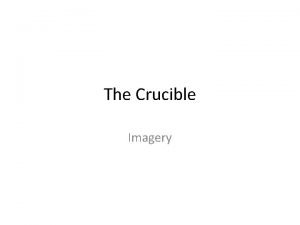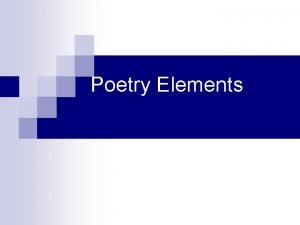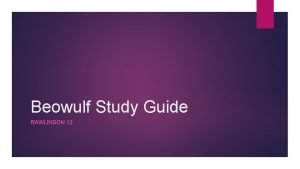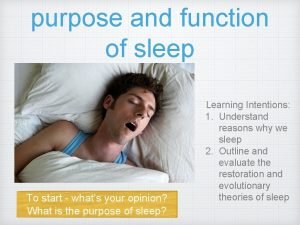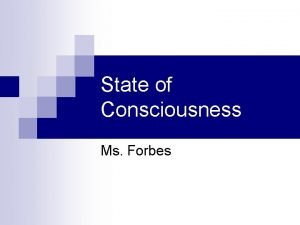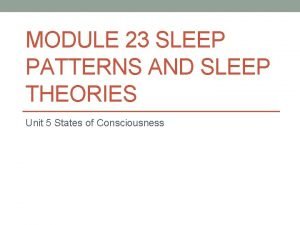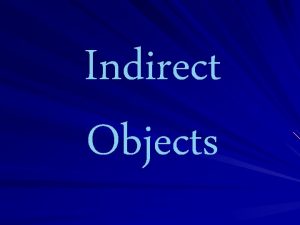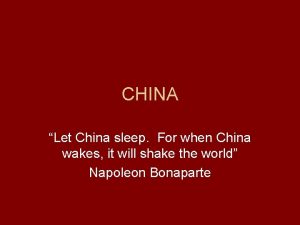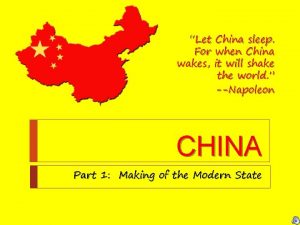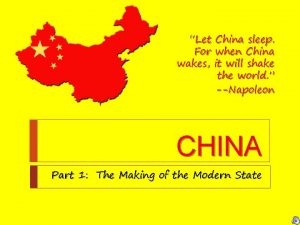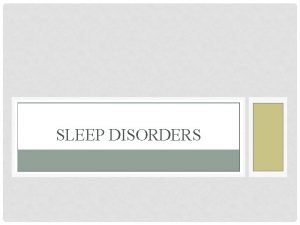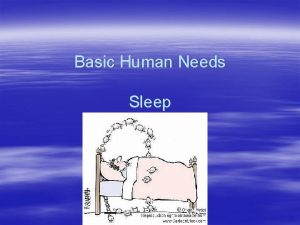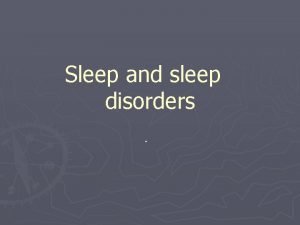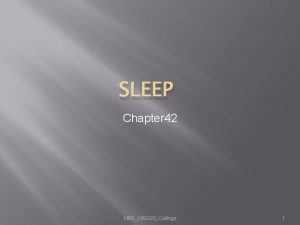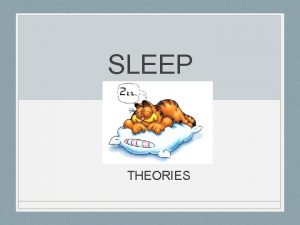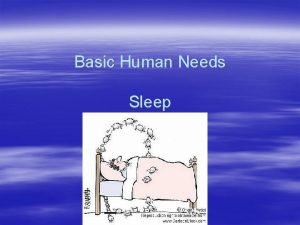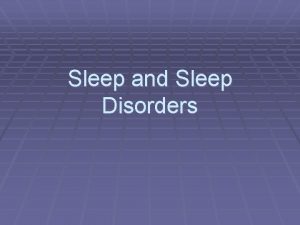Let China sleep For when China wakes it

















- Slides: 17

“Let China sleep. For when China wakes, it will shake the world. ” --Napoleon CHINA Part 1: The Making of the Modern State

Why do we study China? � Unique history greatly shapes political culture � One of the few remaining communist nations � Successful move towards capitalism BUT remains highly authoritarian � Questions to ponder… Will democratization follow economic reform success? � Will human rights violations keep China from global partnerships? � What type of change (if any) will Xi Jinping bring? �

Geography Basics � Officially, the People’s Republic of China (PRC) � 4 th largest country 9, 596, 961 sq mi � Less than 15% of land good for agriculture � � Largest � population 1. 3 billion – concentrated in the East *23 provinces � 5 autonomous regions � 4 centrally administered cities � 2 Special Administrative Regions (SAR) �

Geography Basics � � Major Cities: Shanghai 16. 575 million; BEIJING (capital) 12. 214 million; Chongqing 9. 401 million; Shenzhen 9. 005 million; Guangzhou 8. 884 million Taiwan � � � Autonomous Region: � � Location of the exiled government (Republic of China) beginning in the late 1940 s China considers Taiwan a province, Taiwan considers itself independent International recognition is mixed - The United States has deliberately avoided the issue of defining China’s borders A territorial unit that is equivalent to a province and contains a large concentration of ethnic minorities Ex: Tibet Have some autonomy in the cultural sphere but in most policy matters are strictly subordinate to the central govt Special Administrative Regions � � � Hong Kong & Macau (muh-cow) are ruled indirectly by China Hong Kong was claimed by the British in the mid-1800 s, and then transferred the People’s Republic of China (PRC) in 1997 Enjoy a high degree of autonomy in all matters except foreign affairs and defense for the next 50 years

Critical Junctures: Confucius � Imperial China (2000 years) & Confucianism � Harmony, order, and peace � Five duties of universal obligation basic human relations � Obedience to Authority, Hierarchy, Meritocracy � Civil service was created � Had to pass exams based on Confucian ethics � Ethnocentrism or

Critical Junctures: Confucius � Discussion Question: What elements of Confucianism do you think can be found in modern Chinese political culture?

Critical Junctures: Confucius � Discussion Question: What elements of Confucianism do you think can be found in modern Chinese political culture? �Obedience to authority – acceptance of authoritarian rule �Hierarchy – structure of the CCP

Critical Junctures: The Republic of China � 1839 -1949: Century of Humiliation � Economic stagnation/poverty � Increased pressure from the outside/imperialism � Dynastic rule ends � Loss of Hong Kong to GB after Opium Wars 1841 � Nationalism rises! � Revolution! of China � Sun (1911 -12) Establishes Republic Yat-sen became President – US Education � Believed in nationalism, democracy, & Sun Yat-sen social welfare Father of the Republic � Could not hold power Father of the Revolution � Warlords rule

Critical Junctures: The Republic of China � 1911 – 1949 Two political forces vie for power: � The Nationalist Party (KMT) � Led by Sun Yat-Sen � Focused on resisting foreign influence � Favored modernization and reform � Eventually led by Chiang Kai-Shek (1928) � Chinese � Led Communist Party (CCP, founded 1921) by Mao Zedong � By 1928, the CCP was forced West out of Chiang Kai-Shek Leader of Nationalist Party the cities and into the countryside (China is 80% rural at this time)

Critical Junctures: The People’s Republic of China � 1934 -1935: The Long March � Mao & supporters flee from Nationalist forces & gain support in the countryside (Mao becomes a hero to peasant class) � 1941 -1945: World War II � Communists more successful against Japan � 1949: The People’s Liberation Army marches into Beijing unopposed, establishing the People’s Republic of China (PRC) � The Nationalists fled to Taiwan, where they established the Republic of China (ROC) � (international community does not recognize PRC until 1970 s!)

Critical Junctures: Maoism � Maoism – form of communism that believed in the strength of the peasant � Key Values: � Collectivism – loyalty to party and state � Struggle and Activism – for the people � Egalitarianism – Gender equality � “women hold up half of the heaven” � Self-Reliance – people in charge of destiny � Mass Line: leaders would communicate their will/direction to people, but people would communicate through mass line their wisdoms to leaders

Critical Junctures: Maoism � The Soviet Model (1949 -1957): financial support from USSR � Land Reform � Redistributed property from rich to poor and increased productivity in countryside � Civil Reform � Free people from Opium addiction � Enhanced women’s legal rights � Five-Year Plans � Nationalized industry � Collectivized agriculture � Private property eliminated

Critical Junctures: Maoism � Discussion Question: Compare how the Communist Party came to power in China with how it came to power in Russia – how was it different? � How was Maoism similar to Marxist-Leninism in the Soviet Union? Different?

Critical Junctures: Maoism � Discussion Question: Compare how the Communist Party came to power in China with how it came to power in Russia – how was it different? � China: Communists won popular support by defeating Japan in WWII and then defeating the Nationalists in a civil war. Then they established a communist state, the PRC, which replaced the republic of 1911 � Russia: Bolsheviks led a communist revolution & overthrew the czar � How was Maoism similar to Marxist-Leninism in the Soviet Union? Different? � Similar: Democratic Centralism (Communist Party best directs needs of the masses); collectivization; nationalized industry

Critical Junctures: Maoism � The Great Leap Forward (1958 -1966) � Wanted to free China from Soviet domination � Utopian effort to transform China into a radical egalitarian society � Reorganizes China into communes that would serve all basic social and economic functions � (all around development – equal emphasis on industry AND agriculture) � Backyard furnaces – making steal in the countryside � Mass Mobilization (turn #s into asset) � Red vs. Expert – emphasis on party workers Not bureaucrats, Cadres (lower level of party) � Failure – Famine – 18 -45 million deaths

Critical Junctures: Maoism � The Cultural Revolution (1966 -1976) � Goal – remove all vestiges of “old” China and its inequality � Scholars sent to fields to work � Universities/libraries destroyed � Emphasis on elementary education only � Student radicals (Red Guard) lead a purging of “class enemies” � http: //www. youtube. com/watch? v=M 5 Os 4 xdm 5 l. I

Critical Junctures: Maoism � 1976: Mao dies leaving followers divided into factions – each w/ ties to Long March � Radicals – led by Mao’s wife �One of the “Gang of Four” who supported radical goals of cultural revolution � Military � Moderates – moderates who emphasized economic modernization and some contact with other countries � Moderates win and arrest Gang of Four � Crash Course World History – China’s Revolutions
 When china wakes it will shake the world
When china wakes it will shake the world Let china sleep
Let china sleep Let me let me let me
Let me let me let me Imagery in the crucible act 1
Imagery in the crucible act 1 Oodles of noodles poem
Oodles of noodles poem When the dragon wakes what is missing from his treasure
When the dragon wakes what is missing from his treasure Come sleep o sleep analysis
Come sleep o sleep analysis Module 23 sleep patterns and sleep theories
Module 23 sleep patterns and sleep theories Adults spend about ______% of their sleep in rem sleep.
Adults spend about ______% of their sleep in rem sleep. Module 16 sleep patterns and sleep theories
Module 16 sleep patterns and sleep theories Module 23 sleep patterns and sleep theories
Module 23 sleep patterns and sleep theories He who has ears let him hear
He who has ears let him hear Indirect object answers the question
Indirect object answers the question What did you say
What did you say Ministerstyre för och nackdelar
Ministerstyre för och nackdelar Bamse för de yngsta
Bamse för de yngsta Verktyg för automatisering av utbetalningar
Verktyg för automatisering av utbetalningar Tillitsbaserad ledning
Tillitsbaserad ledning
